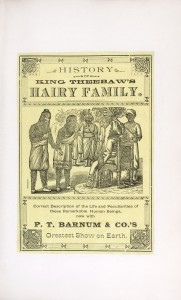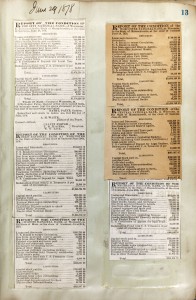Scrapbooking is quite the popular hobby today, but it’s hardly a new idea. People have been compiling images, memorabilia, and the written word since these things existed. While exploring yet another of the American Antiquarian Society’s hidden gems, I found we have a wonderfully rich scrapbook collection.
The collection of scrapbooks at AAS is currently at about 300 volumes, but this number is always growing, whether through new acquisitions or discovery in the stacks. Initially scrapbooks were cataloged into the regular book collection. However, over time, many have been pulled out and we are in the process of integrating all scrapbooks into our manuscript collection. Why move them? Technically, scrapbooks are not published works. Many of them contain clippings from published works, or are sometimes even indeed published works, but with various items (photographs, letters, newspapers clippings, etc.) interfiled within the book’s pages. Scrapbooks take on their own unique identity, unlike any other published work out there. And this uniqueness is what defines a manuscript. So into the manuscript collection they shall go!
 You never know what you’re going to find in a scrapbook, which is what makes them such amazing resources. The contents, nature, and character of each scrapbook depends entirely on the creator. Topics can be anything from flowers, to local history, to simply random newspaper clippings someone found interesting. Just the other day, a reader was looking for resources about P.T. Barnum, and amazingly, we have a scrapbook done by a person who was interested in what he termed “Freaks of Nature.” Hence we were able to provide a scrapbook filled with various images, newspapers articles, fliers (like the one pictured to the left) and clippings from published works, many about P.T. Barnum’s circus. On occasions such as this, a scrapbook can end up being one of the best resources for a project.
You never know what you’re going to find in a scrapbook, which is what makes them such amazing resources. The contents, nature, and character of each scrapbook depends entirely on the creator. Topics can be anything from flowers, to local history, to simply random newspaper clippings someone found interesting. Just the other day, a reader was looking for resources about P.T. Barnum, and amazingly, we have a scrapbook done by a person who was interested in what he termed “Freaks of Nature.” Hence we were able to provide a scrapbook filled with various images, newspapers articles, fliers (like the one pictured to the left) and clippings from published works, many about P.T. Barnum’s circus. On occasions such as this, a scrapbook can end up being one of the best resources for a project.
 Another interesting scrapbook from our collection is a compilation of various Worcester banks’ dividend earnings in the late 19th century. While certainly not as exciting or intriguing as the “Freaks of Nature” scrapbook, it’s a great way to get a localized glimpse into the economy and banking industry of the time. Imagine the time it would take a modern day researcher to go through issue after issue of newspapers, looking for articles and statements from local banks. But thanks to scrapbooks, if you happen to have the same random interest as a scrapbooker 100 years ago, you’re in luck!
Another interesting scrapbook from our collection is a compilation of various Worcester banks’ dividend earnings in the late 19th century. While certainly not as exciting or intriguing as the “Freaks of Nature” scrapbook, it’s a great way to get a localized glimpse into the economy and banking industry of the time. Imagine the time it would take a modern day researcher to go through issue after issue of newspapers, looking for articles and statements from local banks. But thanks to scrapbooks, if you happen to have the same random interest as a scrapbooker 100 years ago, you’re in luck!
So to all you scrapbookers out there – keep it up! You could be compiling the great primary resources of tomorrow.
